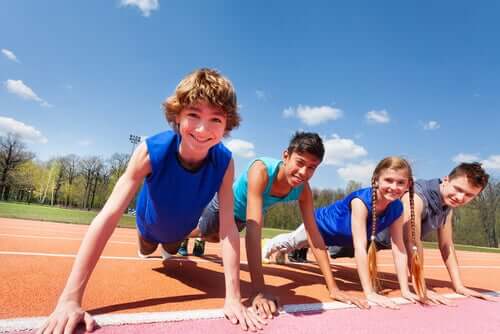Physical Education Games for Kids

Physical education is the favorite subject of the vast majority of children. Its advantage over the others is that instructors can resort to recreational activities to meet the central objectives of the discipline. Here are some physical education games that any little one will love.
Although it’s often underestimated, physical education is a subject that’s just as important as the others. The fact that a large part of the activities are games or sports practices doesn’t mean that they don’t make a significant contribution to the integral development of children.
In fact, physical education games promote values that are difficult to work on in other settings, such as the classroom or rehearsal rooms. Some of them are:
- Teamwork
- Fellowship
- Fair play
- Effort and commitment
- Personal growth
In addition, like any other exercise routine, it has benefits for the body. Among these, we can mention the prevention of sedentary lifestyle and obesity, muscle strengthening, and the development of motor skills.
6 physical education games for kids
For teachers or parents wanting to experience new activities during free afternoons, here are some physical education games for your little ones. They’re fun and practical, so don’t hesitate to try them!
1. Cone carriers
This group balance game is aimed at coordination and teamwork. Teams of two to five members should be formed. Each child will place a cone on their head and, hugging their classmates, will have to transport it to the other end of the room or patio without falling.
If the cone falls off or any of the children let go of the others, they’ll have to start over. The team that completes the tour first with all the cones on their heads wins. It’s very exciting and the kids love it!

2. The guardian: Another classic among physical education games
This is a chasing game that takes a good number of kids to play. It’s one of the favorites for little ones. Two mats should be placed in opposite corners of the patio. In each of them, we must place a group of children; both groups must be of the same number of participants. In the center of the yard, there will be a third group of children, who will be the guardians.
When the teacher says the phrase “the guardians had finished their work, when the (insert name of an animal, for example, cows) escaped”, all the children should try to get to the other “pen”.
The peculiarity is that they must imitate the movement and sounds of the mentioned animal. For children caught by guardians, there are two options: either they wait outside until the game is over or they become guardians themselves.
“Physical education games promote values that are difficult to work on in other areas”
3. The four corners
This is a physical education game based on speed and teamwork. It’s very simple: We must draw a large square in the yard and form five groups of children with the same number of members.
Each group will be placed in a corner and the rest will go to the center. When the teacher gives the signal, each set will have to look for a different corner than the one they’re in. Whoever’s in the center will earn a point. In this game, the team that reaches 5 or 10 points first loses.
It’s important for there to be an adult to watch the children during the game so that collisions don’t occur. In addition, it’s a good opportunity to promote healthy competition and mutual care among colleagues.
4. The silent ball
This activity, although it seems simple, tests the ability of children to follow orders. This is how it’s played: The children must be scattered throughout the yard. Then, one or more balls must be passed between them (depending on the number of players) with the exclusive condition that they can’t speak.
Each player who speaks or who makes a bad throw or reception must fulfill a test imposed by the teacher. It could be running around the yard, doing push-ups, or doing sit-ups. Adding balls progressively will increase the difficulty and fun of this game.

5. The professor’s revenge
Ideal for warming up, this activity consists of distributing the students throughout the yard. In the same way, foam balls will be arranged all over the place. The teacher must give the order and run towards the balls to try to hit the children (below the waist) with them. Any child who fails to dodge a shot must get a penalty, which may be similar to those in the previous game.
“Play is the work of childhood”
–Fred Rogers–
6. Steal the monkey’s tail
This is an ideal game for children between 9 and 12 years old. The children should be distributed throughout the yard, each of them will have a long rope attached to their pants. The strings should be positioned so that they can be easily pulled out and are visible.
The game consists of trying to remove the rope from the opponents without losing your own. The game will end when all the children lose their rope or at the end of a time stipulated by the teacher. In the latter case, the child with a greater amount of strings in their pants will win.
Like these games, there are tons of other games to experiment with children. With a little imagination and inventiveness, you can come up with variations of these or create new games. You won’t need a lot of materials either, so go ahead! Hours of fun await you!
Physical education is the favorite subject of the vast majority of children. Its advantage over the others is that instructors can resort to recreational activities to meet the central objectives of the discipline. Here are some physical education games that any little one will love.
Although it’s often underestimated, physical education is a subject that’s just as important as the others. The fact that a large part of the activities are games or sports practices doesn’t mean that they don’t make a significant contribution to the integral development of children.
In fact, physical education games promote values that are difficult to work on in other settings, such as the classroom or rehearsal rooms. Some of them are:
- Teamwork
- Fellowship
- Fair play
- Effort and commitment
- Personal growth
In addition, like any other exercise routine, it has benefits for the body. Among these, we can mention the prevention of sedentary lifestyle and obesity, muscle strengthening, and the development of motor skills.
6 physical education games for kids
For teachers or parents wanting to experience new activities during free afternoons, here are some physical education games for your little ones. They’re fun and practical, so don’t hesitate to try them!
1. Cone carriers
This group balance game is aimed at coordination and teamwork. Teams of two to five members should be formed. Each child will place a cone on their head and, hugging their classmates, will have to transport it to the other end of the room or patio without falling.
If the cone falls off or any of the children let go of the others, they’ll have to start over. The team that completes the tour first with all the cones on their heads wins. It’s very exciting and the kids love it!

2. The guardian: Another classic among physical education games
This is a chasing game that takes a good number of kids to play. It’s one of the favorites for little ones. Two mats should be placed in opposite corners of the patio. In each of them, we must place a group of children; both groups must be of the same number of participants. In the center of the yard, there will be a third group of children, who will be the guardians.
When the teacher says the phrase “the guardians had finished their work, when the (insert name of an animal, for example, cows) escaped”, all the children should try to get to the other “pen”.
The peculiarity is that they must imitate the movement and sounds of the mentioned animal. For children caught by guardians, there are two options: either they wait outside until the game is over or they become guardians themselves.
“Physical education games promote values that are difficult to work on in other areas”
3. The four corners
This is a physical education game based on speed and teamwork. It’s very simple: We must draw a large square in the yard and form five groups of children with the same number of members.
Each group will be placed in a corner and the rest will go to the center. When the teacher gives the signal, each set will have to look for a different corner than the one they’re in. Whoever’s in the center will earn a point. In this game, the team that reaches 5 or 10 points first loses.
It’s important for there to be an adult to watch the children during the game so that collisions don’t occur. In addition, it’s a good opportunity to promote healthy competition and mutual care among colleagues.
4. The silent ball
This activity, although it seems simple, tests the ability of children to follow orders. This is how it’s played: The children must be scattered throughout the yard. Then, one or more balls must be passed between them (depending on the number of players) with the exclusive condition that they can’t speak.
Each player who speaks or who makes a bad throw or reception must fulfill a test imposed by the teacher. It could be running around the yard, doing push-ups, or doing sit-ups. Adding balls progressively will increase the difficulty and fun of this game.

5. The professor’s revenge
Ideal for warming up, this activity consists of distributing the students throughout the yard. In the same way, foam balls will be arranged all over the place. The teacher must give the order and run towards the balls to try to hit the children (below the waist) with them. Any child who fails to dodge a shot must get a penalty, which may be similar to those in the previous game.
“Play is the work of childhood”
–Fred Rogers–
6. Steal the monkey’s tail
This is an ideal game for children between 9 and 12 years old. The children should be distributed throughout the yard, each of them will have a long rope attached to their pants. The strings should be positioned so that they can be easily pulled out and are visible.
The game consists of trying to remove the rope from the opponents without losing your own. The game will end when all the children lose their rope or at the end of a time stipulated by the teacher. In the latter case, the child with a greater amount of strings in their pants will win.
Like these games, there are tons of other games to experiment with children. With a little imagination and inventiveness, you can come up with variations of these or create new games. You won’t need a lot of materials either, so go ahead! Hours of fun await you!
All cited sources were thoroughly reviewed by our team to ensure their quality, reliability, currency, and validity. The bibliography of this article was considered reliable and of academic or scientific accuracy.
- Brasó, R. J., & Torrebadella, F. X. (2019). El juego popular de las cuatro esquinas: 30 variantes para recuperar su uso en la educación del siglo XXI. Historia de la Educación, (38), 155-177. https://ddd.uab.cat/record/230694
- Muñoz, A. V., Lavega, B. P., Costes, R. A., Damian, S. S., & Serna, J. (2020). Los juegos motores como recurso pedagógico para favorecer la afectividad desde la educación física. Retos. Nuevas tendencias en Educación Física, Deporte y Recreación, 38, 166-172. https://repositori.udl.cat/items/d1384165-f896-4a96-a616-f17c81ae139e
- Olmo, A. R., & Flix, X. T. (2021). Deconstruyendo y (re) construyendo el juego de «la Bandera» de Baden-Powell. Foro de Educación, 19(2), 335-362. https://www.forodeeducacion.com/ojs/index.php/fde/article/view/728/491
- Renzi, G. M. (2009). Educación Física y su contribución al desarrollo integral de los niños en la primera infancia. Revista Iberoamericana de Educación, 50(7), 1-14. https://dialnet.unirioja.es/servlet/articulo?codigo=3069980
This text is provided for informational purposes only and does not replace consultation with a professional. If in doubt, consult your specialist.








